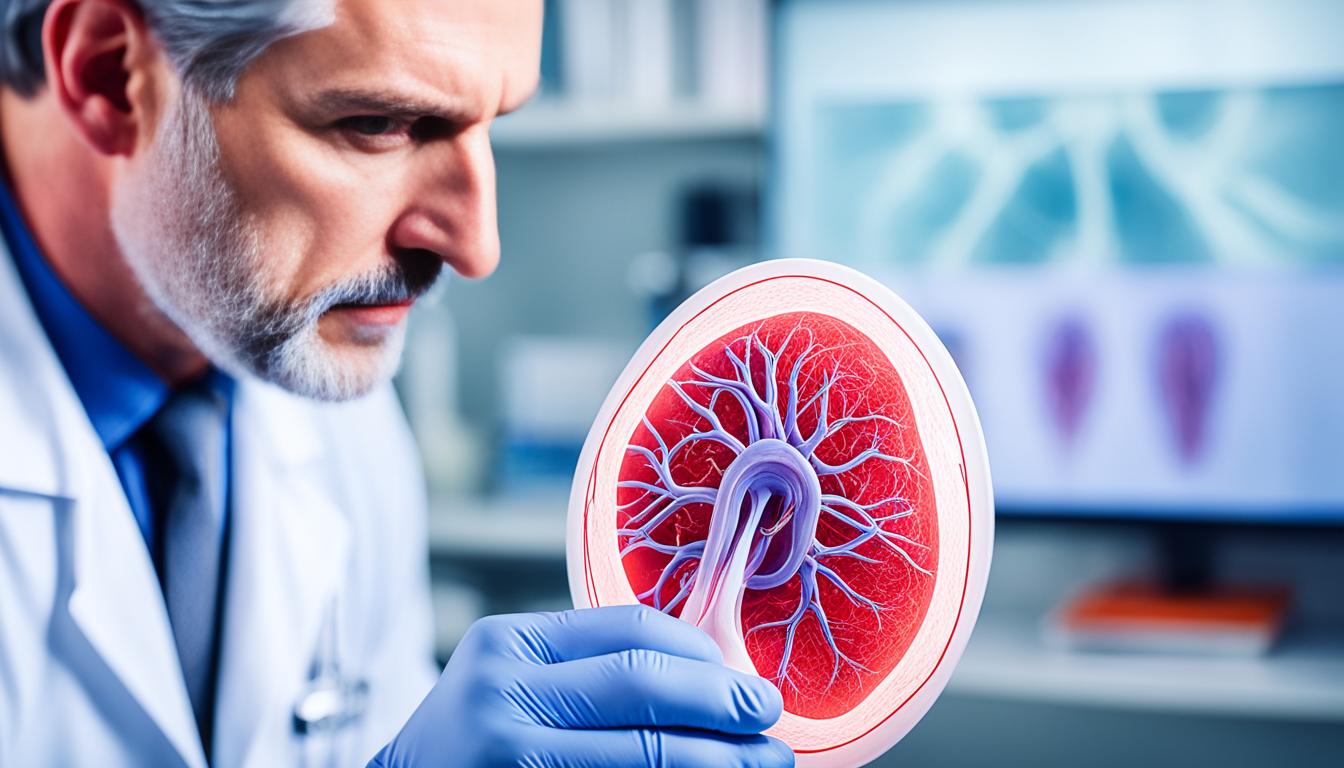Testicular torsion is an emergency often seen in kids. It’s important to spot the signs early and get treatment fast. This helps avoid serious issues like the death of the testicle. Signs may include sharp pain in the testicle, swelling in the scrotum, and a testicle that’s turned. Getting diagnosed quickly is key. A color Doppler ultrasound can confirm if it’s testicular torsion. The best time to treat it is less than 6 hours from the start of symptoms. In surgery, doctors fix the problem by turning back the twisted cord and securing the testicle.
Key Takeaways:
- Testicular torsion is an emergency often seen in kids.
- Watch for signs like sudden testicle pain, scrotum swelling, and a change in the testicle’s position.
- Quick diagnosis with a color Doppler ultrasound is vital for fast treatment.
- The best time to treat it is within 6 hours of symptom start.
- Surgery aims to fix the twist and prevent it from happening again.
Recognizing Testicular Torsion: Signs, Causes, and Diagnosis
Testicular torsion is a condition that causes intense and sudden pain. It’s felt in the scrotum, testicle, belly, or groin. This pain means you need to see a doctor right away. Immediate treatment is vital to avoid serious issues, like permanent harm or losing the testicle. Knowing the signs, causes, and how doctors diagnose testicular torsion is key.
This condition happens when the testicle twists, stopping its blood flow. Reasons for this twist might include quick growth during puberty, or a birth defect called bell clapper anomaly.
A doctor will do a detailed check-up to find out if you have testicular torsion. They might do a scrotal exam and perhaps an ultrasound too. These steps help them see if torsion is present and how serious it is.
Getting help early is extremely important if you think you have testicular torsion. The quicker it’s found and treated, the better the chance of saving the testicle and avoiding lasting problems. Waiting to get treated could cause the testicle to die.
Signs of Testicular Torsion
- Sudden, intense pain in the scrotum, testicle, belly, or groin
- The scrotum might swell and be painful to touch
- The testicle might sit higher than usual
Causes of Testicular Torsion
- Rapid growth during puberty
- The bell clapper anomaly lets the testicle twist freely
Diagnosis of Testicular Torsion
Checking for testicular torsion might involve a few steps:
- The doctor could do a scrotal exam. This checks for swelling and tenderness, and they might do a blood flow test.
- They might also do a scrotal ultrasound. It’s a quick and pain-free way to see if there’s enough blood flowing to the testicle.
It’s really important to know the signs, causes, and how doctors check for testicular torsion. If you think you or someone you know might have it, don’t wait. Get medical help right away for the best chances of healing.
| Signs of Testicular Torsion | Causes of Testicular Torsion | Diagnosis of Testicular Torsion |
|---|---|---|
| Sudden and severe pain in the scrotum, testicle, belly, or groin | Rapid growth during puberty | Scrotal exam |
| Swelling and tenderness in the scrotum | Bell clapper anomaly | Ultrasound |
| Change in the position of the affected testicle |
Emergency Treatment and Prevention of Testicular Torsion
Testicular torsion is a very serious issue that needs fast action. A doctor must quickly perform surgery to fix it and save the testicle. Waiting too long can mean losing the testicle and facing lasting health and emotional issues.
The primary way to treat testicular torsion is through surgery. Doctors perform a procedure called orchiopexy with detorsion. This involves untwisting the testicle to bring back blood flow. Then, the testicle is fixed in place to stop it from twisting again. Acting fast to get medical help is key in saving the testicle.
It’s hard to avoid testicular torsion, but knowing about it and acting quickly can prevent serious harm. Parents should teach their sons to recognize and report any unusual pain in the scrotum, groin, or belly. Talking openly can lead to getting the needed medical care on time and possibly saving the testicle.
FAQ
Q: What are the symptoms of testicular torsion?
A: Symptoms of testicular torsion are sudden and severe pain in one testicle. You might also see swelling and feel pain in your scrotum. There could be a change in the twisted testicle’s position.
Q: How is testicular torsion diagnosed?
A: Doctors diagnose testicular torsion by looking at your symptoms. They might also do a scrotal exam and use ultrasound to confirm it.
Q: What is the emergency treatment for testicular torsion?
A: Testicular torsion needs emergency surgery. This surgery, called orchiopexy with detorsion, untwists and secures the testicle.
Q: Can testicular torsion be prevented?
A: Unfortunately, you can’t prevent testicular torsion. But, early treatment may stop any long-term harm. It’s vital for parents to talk to their sons about pain in the scrotum, groin, or belly. Timely medical help is everything.

